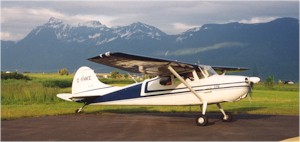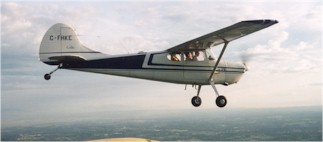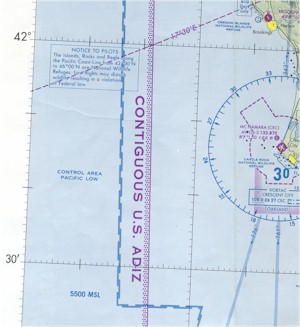Learning to fly.
Lesson Three, Inflight Exercises, Pitch.
In the last lesson we learned about how the
controls are used to create movements that allow us to manoeuvre
in the air. In this lesson we will apply what we have
learned.
First of all I need to give you a couple of
definitions!
- Angle
of Attack.
The angle of
attack is the angle at which the wing meets the air. A wing
has a curved shape that is called an Airfoil and this
is designed to create Lift in the most efficient way
for the particular aeroplane. To create lift the airfoil has
to be at an angle to the airflow. To experiment for
yourself, just stick your hand into the Slipstream
that passes your car as you are driven along a road; if your
hand is directly in line with the slipstream there’s no
lift, but if you angle your hand to the airflow it will lift
up, or down. This angle of your hand to the airflow is
called its Angle of Attack. A wing needs a positive
angle of attack to develop lift to keep the aeroplane in the
air.

In the "three point", landing attitude this
Cessna
170's wing reaches a high angle of attack to
provide lift at low airspeed for comfortable
landings. |

The same aeroplane in cruising flight where the wing
is able to develop the same amount of lift with a
smaller angle of attack due to to its higher
airspeed. |
- The
Knot.
The only true
measure of distance on the Earth’s surface is called the
Nautical Mile. It is easily measured on a map because
it equals 1 Minute of Latitude. There are
60 minutes in one degree, and there are 180 degrees of
latitude from the North Pole to the South Pole. Knots
are Nautical Miles Per Hour and the Airspeed
Indicator is calibrated to read airspeed in Knots.
1 Knot = 1.85 Kilometres Per Hour, so an airspeed of 100
Knots = 185 Kph.
 |
Here we see a section of a map. From 41°30' to
42° is 30 Nautical Miles
We can measure distances directly off the map if
we
use nautical miles as minutes of latitude using a
line of
longitude (Meridian) as a scale.
Minutes of longitude cannot be used for this
purpose
since these get smaller as we approach the poles.
|
Now let's get down to the nitty gritty of
this lesson…
First of all there is one basic rule to be
learned, that is Attitude + Power = Performance!
A Cessna 152 will cruise happily at 80 Knots
with a power setting that gives 2,000 rpm, and with the nose just
below the horizon. To an extent, Attitude can be
said to control the airspeed. If we do nothing else but lower the
nose, then the speed will increase, just like rolling your car
down a hill, and if the nose is raised above the horizon, just
like rolling the car up a hill, the speed will decrease. This
idea will be very important later when we have to land the
aeroplane!
Supposing we want to increase our cruise
speed to 90 Knots. We will need to lower the nose to gain
the speed, but, if we do, we will lose height! So first we
add more Power, maybe 2,200 rpm will do the trick, and
then lower the nose (Attitude) slightly as the aeroplane
accelerates to achieve the new cruising speed. At this
higher speed the wing needs to meet the airflow at a smaller
angle of attack to generate the required lift… Do you
remember the Trim? Yes! we have to trim the
aeroplane to fly at the new attitude and speed. So to
increase our cruise speed, we need to apply the correct Power,
lower the nose Attitude by moving the control column
forward as the aeroplane accelerates, and then Trim to
remove the control forces so that the aeroplane can fly
"Hands Off".
Conversely, to fly at a reduced cruise
speed, we reduce the Power, raise the nose to a higher
nose Attitude as the aeroplane decellerates, and then Trim
it once again.
In a car you have to put your foot down on
the accelerator to go up a hill, likewise an aeroplane needs more
Power to climb higher. If the aeroplane is trimmed
to fly level at 80 Knots and we add power, the nose will rise
automatically into the climb Attitude and the aeroplane
will continue at the same airspeed. Even though the nose is
now above the horizon, the Angle of Attack is the
same! The attitude of the aeroplane is not necessarily an
indicator of the angle of attack of the wings. In this case
the Power and Attitude have been altered to give
climb Performance.
Conversely, if we reduce the power to give 1800 rpm while trimmed
to fly at 80 Knots in level flight at 2,000 rpm, the nose will
automatically lower itself to maintain the trimmed speed, and the
aeroplane will descend.
In the next lesson we will carry out turns.
© Michael Peare 2015


